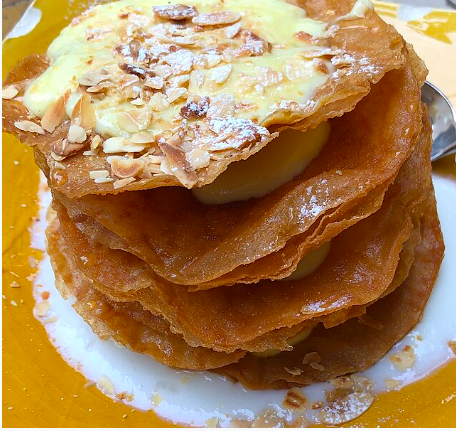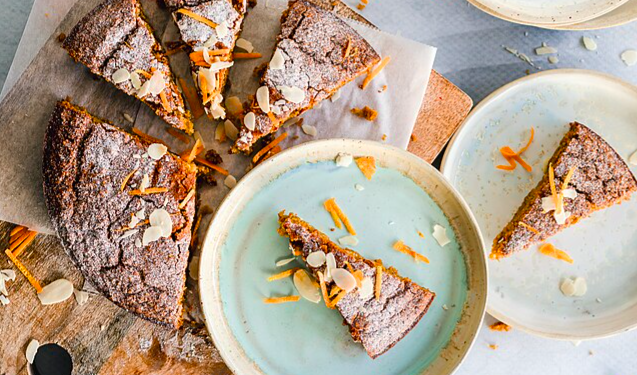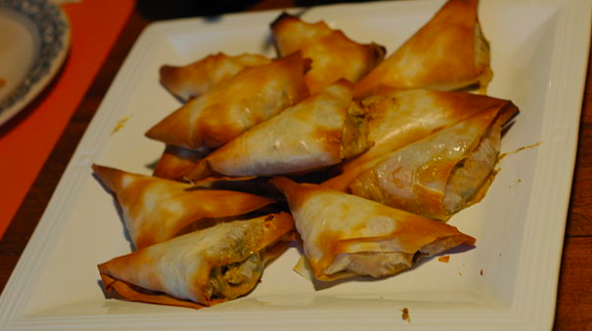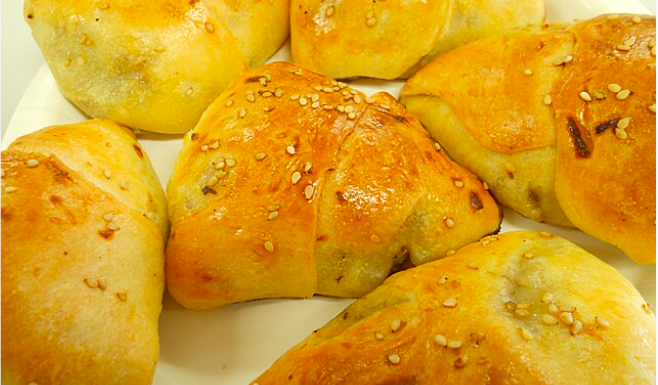Historic Sweets from North Africa
By: Habeeb Salloum/Arab America Contributing Writer

The delicious desserts of North Africa are not the invention of today but have a history that goes back to Moorish Spain when in the palaces and villas of the elite and nobility, no table of any self-respecting host would be without trays of succulent sweets. Today, these sweets are usually offered with refreshing mint tea sometime after a meal in, often attractive Moorish type surroundings.
There were two evenings I spent in North Africa which made me a true connoisseur of North African sweets. The first was a feast day that we spent at the home of a friend in Rabat, the beautiful capital of Morocco. After having dined on a diffa, a royal Moroccan feast, late in the evening we ended our fairy-tale feast with glasses of refreshing mint tea in a charming Moorish style room, accompanied by platters of the most prized of North African sweets: braiwat, an almond-filled honey-dipped pastry and m’hansha, a coiled filo nut-filled pastry.
The second time was in Tunisia when a friend who I had known in Canada and who had later returned to Tunisia invited us to an authentic Tunisian feast in his home to celebrate the end of Ramadan.
Our hostess set before us a whole series of Tunisian dishes that diffused an intoxicating aroma. Our host, in the usual Arab fashion, encouraged us on to eat and to enjoy. This we did, each dish being more delectable than the next. While we dined, in the background soft strains of Andalusian Arab music put us at ease. The soothing melodies and the subtle spicy taste of the colourful food created a happy and relaxing atmosphere at our friend’s hospitable table.
That evening after we were sated and samsa, a flaky almond and sesame seed pastry accompanied by mint tea ended our Tunisian feast of culinary perfection. It was a feast I will always remember.
These two invitations set me on the road to discover the joys of North African sweets. Later I made more than a dozen trips to that part of the world. When I returned home, I always replicated them with my own versions. These below are a sample of these ageless sweets, most modified somewhat by the utensils and ingredients of the modern age.
Date and Almond Cookies – Tamar bil-Lawz Mitabukeen

Makes about 3 dozen
These Moroccan cookies are often found on that country’s table of sweets. A must for those who enjoy the flavour of fruit and nuts.
1/3 cup butter
2 eggs
1/2 cup cream
l teaspoon vanilla
1 1/2 cups flour
1 teaspoon baking powder
1/2 teaspoon baking soda
1 cup pulverized almonds
1 cup finely chopped dates
1 cup sugar
1/2 teaspoon salt
Place all ingredients in a food processor; then process into a soft paste, adding a little water if necessary. Form cookies by placing 1 heaping tablespoon of paste at a time on well-greased baking trays. Bake in a 350° F preheated oven for 10 minutes or until cookies turn golden brown.
Honey Dipped Pastry – Briwaat

Makes approximately 36
Unlike in the eastern Arab lands where honey is rarely used in the preparation of pastry, in Morocco and generally throughout North Africa, this bee product is extensively used in the preparation of sweets. The tradition of using honey to create mouth-watering desserts was brought to North Africa by the expelled Arabs from the Iberian Peninsula.
1 cup blanched almonds
1/2 cup sugar
1/2 teaspoon cinnamon
1 tablespoon butter
1 egg
1 one-pound package filo dough, thawed according to package directions
2 cups cooking oil
2 tablespoons orange blossom water
2 cups honey
Place almonds and sugar in a blender, then blend until the almonds turn semi-fine. Stir in cinnamon and butter; then set aside.
In a small bowl, beat egg then set aside.
Cut each filo sheet into two, lengthwise, then place around 1 tablespoon of almond mixture near the right-hand bottom corner of each half-sheet. Fold sheet in half lengthwise over the filling, then fold closed sheet upward into a 3 by 2-inch rectangle or a triangle shape. Brush seams with egg and set aside.
In a saucepan heat oil over medium and place briwaat in oil. Fry until briwaat until deep golden in colour.
In the meantime, place orange blossom water and honey in a saucepan and thoroughly heat, then lower heat to very low. Remove briwaat from oil with a slotted spoon, then place in honey for few minutes. Remove briwaat from honey then place in a strainer until honey
drains.
The Snake – M’hansha
Makes two 9-inch rounds
North African tradition makes claim that this sweet originated in Arab Spain. It gets its name from its snake-like shape ad has been found on the tables of emirs and sultans for centuries.
4 cups ground almonds
1 3/4 cups granulated sugar
1 tablespoon orange blossom water
1 pound filo pastry, thawed according to package directions
1 cup clarified butter, melted
2 eggs
Confectioner’s/icing sugar
1 tablespoon cinnamon
To make the filling, mix the almonds, the sugar, and the orange blossom water in a
bowl. Place the mixture in a food processor and process for 1 minute.
In a large-sized saucepan, add 1/4 cup of the butter and add the filling. Over low heat, cook the filling stirring constantly to avoid sticking for 1 minute. Remove from the heat and allow to cool.
Beat one of the eggs and stir into the filling, mixing well.
Place the filling in the processor and process for 1 minute. Divide the filling into 9, 11 or 12 parts, depending on the total number of filo sheets. (If the package of filo pastry contains 24 sheets, divide the filling into 12 parts; if it contains 22 sheets, then divide the filling into 11 parts; if the package contains 18 sheets, divide the filling into 9 parts.)
Beat the remaining egg and set aside.
Take 2 filo pastry sheets and lay lengthwise, one on top of the other, on a flat surface. Brush the top sheet with the butter.
Take 1 of the parts of the filling and spread along the bottom of the filo pastry. Starting from the bottom, roll the 2 sheets of filo, tucking in the sides, upwards forming into a long cigar shape. Brush the egg along the seam of the roll.
Place the rolled pastry piece in a greased 9-inch pie plate by coiling it around the edge of the pan, seam side down. Continue filling and rolling the filo and placing the rolls next to the ones already in the pie pan by coiling until the pan is filled. Each 9-inch pie plate should take from 5 to 6 rolls. Brush the top of m’hansha with the remaining butter and the beaten egg.
Bake the m’hansha at 325o F for 35 to 40 minutes. If the top is not browned, place under the broiler until golden. Cool completely.
Sprinkle the m’hansha generously with the confectioner’s/icing sugar and then decorate with the cinnamon.
Tunisian Almond and Sesame Seed Pastry – Samsa

Makes 35 to 40 pieces
Many of the mouth-watering desserts of North Africa have their origin in al-Andalus, the Arab created earthly paradise in the Iberian Peninsula. One has to only read Ibn Razeen at-Tujeebee’s 13th century culinary work entitled Fadaalat al-Khiwaan fee Tayyibaat at-Ta`aam wa al-Alwaan to know that the sweets North Africans prepare today had a history in Arab Andalusia.
Syrup:
2 cups sugar
1 cup water
2 tablespoons lemon juice
1 tablespoon orange blossom water (mazahar)
1 1/2 cups almonds, blanched
1 1/2 cups white sesame seeds
1 one-pound package filo dough thawed according to package directions
Prepare the syrup: In a medium-sized saucepan, stir together the water, sugar and lemon juice then bring to a boil over medium heat. Continue simmering for 7 minutes then stir in the lemon juice and allow to simmer for 7 more minutes. Stir in the orange blossom water, reduce the heat and cook for a further 1 minute. Set aside.
Preheat the oven to 350o F, then spread almonds and sesame seeds evenly on a large shallow pan. Bake until they turn light brown, stirring occasionally so that they brown evenly. Pulverize browned almonds and sesame seeds in a blender then set aside.
In a well-buttered 9 x 13-inch baking pan, place 1 sheet of filo dough, then brush with butter. Repeat procedure until 1/3 of the sheets are used.
Spread 1/2 of almond and sesame seed mixture on the filo dough then add another 1/3 of dough, sheet by sheet, buttering them as before. Spread remaining almond and sesame seed mixture on the dough, then cover with the remaining 1/3 of the dough, buttering sheet by sheet as before.
Brush top with remaining butter, then with a sharp knife carefully cut into squares or diamond shapes. Bake in a preheated oven of 400o F for 5 minutes, then lower heat to 300o F and bake for approximately 30 minutes, or until the sides are golden.
While the samsa is baking, prepare qatar (syrup), then set aside, but keep warm.
Before removing samsa from oven, place under broiler for a few moments, turning tray around until top is evenly golden. Remove from oven then pour syrup evenly over top of hot samsa. Allow to cool then serve.
Note: If a dryer type of samsa is desired, prepare only half the syrup.


